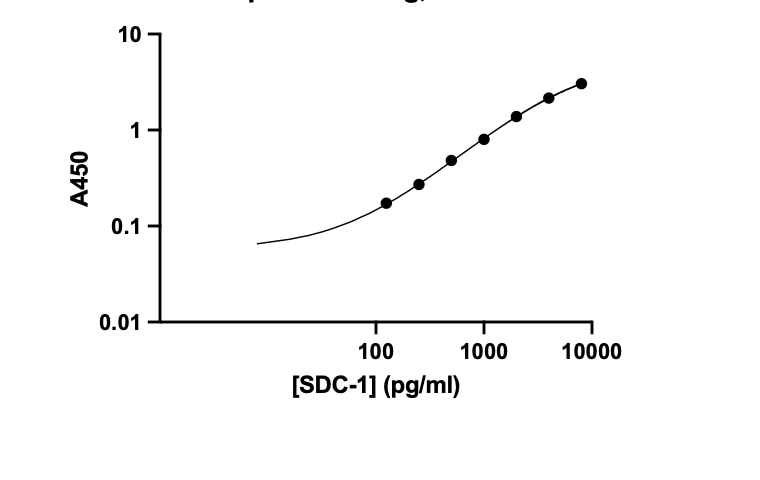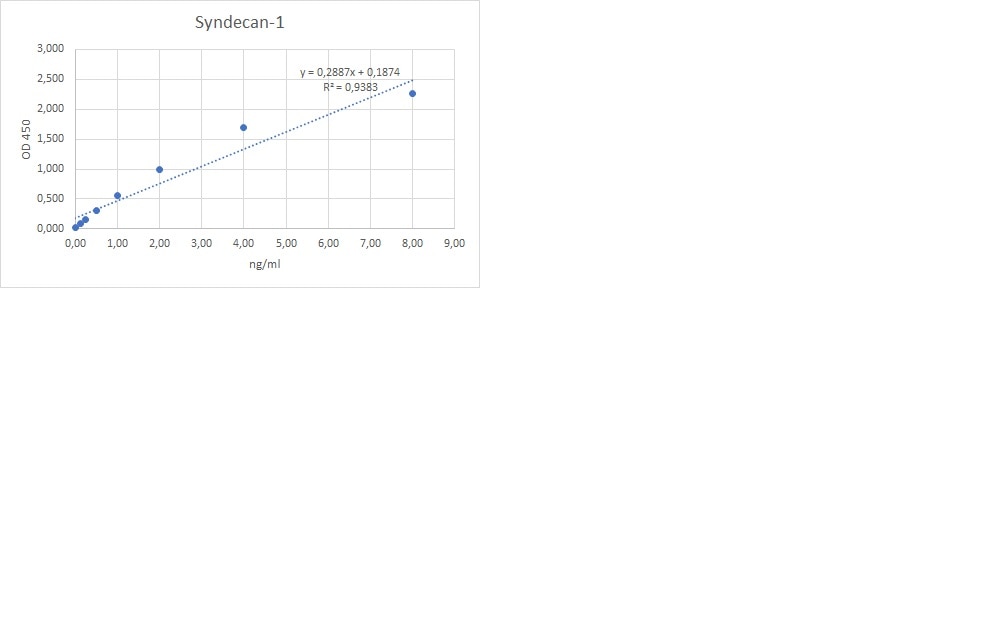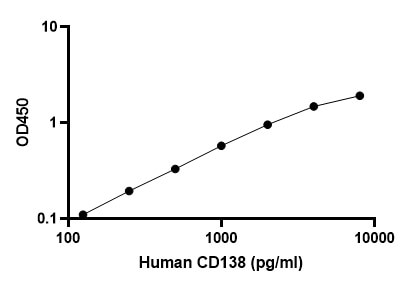Human Syndecan-1 DuoSet ELISA Summary
* Provided that the recommended microplates, buffers, diluents, substrates and solutions are used, and the assay is run as summarized in the Assay Procedure provided.
This DuoSet ELISA Development kit contains the basic components required for the development of sandwich ELISAs to measure natural and recombinant human Syndecan-1. The suggested diluent is suitable for the analysis of most cell culture supernate samples. Diluents for complex matrices, such as serum and plasma, should be evaluated prior to use in this DuoSet.
Product Features
- Optimized capture and detection antibody pairings with recommended concentrations save lengthy development time
- Development protocols are provided to guide further assay optimization
- Assay can be customized to your specific needs
- Economical alternative to complete kits
Kit Content
- Capture Antibody
- Detection Antibody
- Recombinant Standard
- Streptavidin conjugated to horseradish-peroxidase (Streptavidin-HRP)
Other Reagents Required
DuoSet Ancillary Reagent Kit 2 (5 plates): (Catalog # DY008) containing 96 well microplates, plate sealers, substrate solution, stop solution, plate coating buffer (PBS), wash buffer, and Reagent Diluent Concentrate 2.
The components listed above may be purchased separately:
PBS: (Catalog # DY006), or 137 mM NaCl, 2.7 mM KCl, 8.1 mM Na2HPO4, 1.5 mM KH2PO4, pH 7.2 - 7.4, 0.2 µm filtered
Wash Buffer: (Catalog # WA126), or 0.05% Tween® 20 in PBS, pH 7.2-7.4
Reagent Diluent: (Catalog # DY995), or 1% BSA in PBS, pH 7.2-7.4, 0.2 µm filtered
Substrate Solution: 1:1 mixture of Color Reagent A (H2O2) and Color Reagent B (Tetramethylbenzidine) (Catalog # DY999)
Stop Solution: 2 N H2SO4 (Catalog # DY994)
Microplates: R&D Systems (Catalog # DY990)
Plate Sealers: ELISA Plate Sealers (Catalog # DY992)
Scientific Data
Product Datasheets
Preparation and Storage
Background: Syndecan-1/CD138
Syndecans are type 1 transmembrane proteoglycans that constitute the major physiological form of heparan sulfate (HS) on the cell surface. The four vertebrate syndecans, Syndecan-1 through -4, have similar short cytoplasmic domains and extracellular portions that diverge, except for HS attachment sites. Structurally diverse side chains add considerably to the size of the core proteins and serve as binding sites for growth factors, cytokines, and extracellular matrix proteins. Syndecans are present as homodimers or multimers, and are often expressed in developmental and cell type-specific patterns. They have many biological roles including regulating cell growth, differentiation, and adhesion.
Assay Procedure
GENERAL ELISA PROTOCOL
Plate Preparation
- Dilute the Capture Antibody to the working concentration in PBS without carrier protein. Immediately coat a 96-well microplate with 100 μL per well of the diluted Capture Antibody. Seal the plate and incubate overnight at room temperature.
- Aspirate each well and wash with Wash Buffer, repeating the process two times for a total of three washes. Wash by filling each well with Wash Buffer (400 μL) using a squirt bottle, manifold dispenser, or autowasher. Complete removal of liquid at each step is essential for good performance. After the last wash, remove any remaining Wash Buffer by aspirating or by inverting the plate and blotting it against clean paper towels.
- Block plates by adding 300 μL Reagent Diluent to each well. Incubate at room temperature for a minimum of 1 hour.
- Repeat the aspiration/wash as in step 2. The plates are now ready for sample addition.
Assay Procedure
- Add 100 μL of sample or standards in Reagent Diluent, or an appropriate diluent, per well. Cover with an adhesive strip and incubate 2 hours at room temperature.
- Repeat the aspiration/wash as in step 2 of Plate Preparation.
- Add 100 μL of the Detection Antibody, diluted in Reagent Diluent, to each well. Cover with a new adhesive strip and incubate 2 hours at room temperature.
- Repeat the aspiration/wash as in step 2 of Plate Preparation.
- Add 100 μL of the working dilution of Streptavidin-HRP to each well. Cover the plate and incubate for 20 minutes at room temperature. Avoid placing the plate in direct light.
- Repeat the aspiration/wash as in step 2.
- Add 100 μL of Substrate Solution to each well. Incubate for 20 minutes at room temperature. Avoid placing the plate in direct light.
- Add 50 μL of Stop Solution to each well. Gently tap the plate to ensure thorough mixing.
- Determine the optical density of each well immediately, using a microplate reader set to 450 nm. If wavelength correction is available, set to 540 nm or 570 nm. If wavelength correction is not available, subtract readings at 540 nm or 570 nm from the readings at 450 nm. This subtraction will correct for optical imperfections in the plate. Readings made directly at 450 nm without correction may be higher and less accurate.
Citations for Human Syndecan-1 DuoSet ELISA
R&D Systems personnel manually curate a database that contains references using R&D Systems products. The data collected includes not only links to publications in PubMed, but also provides information about sample types, species, and experimental conditions.
14
Citations: Showing 1 - 10
Filter your results:
Filter by:
-
Yellow fever disease severity and endothelial dysfunction are associated with elevated serum levels of viral NS1 protein and syndecan-1
Authors: de Sousa, FTG;Warnes, CM;Manuli, ER;Ng, A;Zanella, LGFABD;Ho, YL;Bhat, S;Romano, CM;Beatty, PR;Biering, SB;Kallas, EG;Sabino, EC;Harris, E;
medRxiv : the preprint server for health sciences
Species: Human
Sample Types: Serum
-
Immuno-Modulatory Effects of Dexamethasone in Severe COVID-19-A Swedish Cohort Study
Authors: S Asif, R Frithiof, A Larsson, S Franzén, SB Anderberg, B Kristensen, M Hultström, M Lipcsey
Biomedicines, 2023-01-09;11(1):.
Species: Human
Sample Types: Plasma
-
No association between intravenous fluid volume and endothelial glycocalyx shedding in patients undergoing resuscitation for sepsis in the emergency department
Authors: S Macdonald, E Bosio, NI Shapiro, L Balmer, S Burrows, M Hibbs, T Jowitt, L Smart, G Arendts, D Fatovich
Scientific Reports, 2022-05-24;12(1):8733.
Species: Human
Sample Types: Serum
-
Increased Heparanase Levels in Urine during Acute Puumala Orthohantavirus Infection Are Associated with Disease Severity
Authors: LE Cabrera, C Schmotz, MA Saleem, S Lehtonen, O Vapalahti, A Vaheri, S Mäkelä, J Mustonen, T Strandin
Viruses, 2022-02-22;14(3):.
Species: Human
Sample Types: Urine
-
The Value of Fetuin-A as a Predictor to Identify Takotsubo Patients at Risk of Cardiovascular Events
Authors: A Topf, M Mirna, N Bacher, V Paar, C Edlinger, LJ Motloch, S Gharibeh, M Bannehr, UC Hoppe, M Lichtenaue
Journal of cardiovascular development and disease, 2021-10-05;8(10):.
Species: Human
Sample Types: Serum
-
Circulating syndecan-1 is reduced in pregnancies with poor fetal growth and its secretion regulated by matrix metalloproteinases and the mitochondria
Authors: D Garcha, SP Walker, TM MacDonald, J Hyett, J Jellins, J Myers, SE Illanes, JK Nien, M Schepeler, E Keenan, CA Whigham, P Cannon, E Murray, TV Nguyen, M Kandel, J Masci, C Murphy, T Cruickshan, N Pritchard, NJ Hannan, F Brownfoot, A Roddy Mitc, A Middleton, G Pell, GP Wong, S Tong, TJ Kaitu'u-Li
Scientific Reports, 2021-08-16;11(1):16595.
Species: Human
Sample Types: Cell Culture Lysates
-
Real-time observation of microcirculatory leukocytes in patients undergoing major liver resection
Authors: Z Uz, C Ince, L Shen, B Ergin, TM van Gulik
Scientific Reports, 2021-02-25;11(1):4563.
Species: Human
Sample Types: Plasma
-
Impact of Anesthetic Agents on Endothelial Glycocalyx Injury during Total Knee Arthroplasty: Desflurane- vs. Propofol-Based Anesthesia-A Prospective Randomized Controlled Trial
Authors: CS Oh, JM Choi, EH Park, L Piao, HJ Park, KY Rhee, SH Kim
BioMed Research International, 2021-01-23;2021(0):8880267.
Species: Human
Sample Types: Serum
-
Soluble syndecan-3 binds chemokines, reduces leukocyte migration in vitro and ameliorates disease severity in models of rheumatoid arthritis
Authors: AD Eustace, EF McNaughton, S King, O Kehoe, A Kungl, D Mattey, AH Nobbs, N Williams, J Middleton
Arthritis Res. Ther., 2019-07-12;21(1):172.
Species: Human
Sample Types: Serum
-
Bolus therapy with 3% hypertonic saline or 0.9% saline in emergency department patients with suspected sepsis: A pilot randomised controlled trial
Authors: L Smart, SPJ Macdonald, E Bosio, D Fatovich, C Neil, G Arendts
J Crit Care, 2019-03-28;52(0):33-39.
Species: Human
Sample Types: Serum
-
Endothelial activation, haemostasis and thrombosis biomarkers in Ugandan children with severe malaria participating in a clinical trial.
Authors: Graham S, Chen J, Chung D, Barker K, Conroy A, Hawkes M, Namasopo S, Kain K, Lopez J, Liles W
Malar J, 2016-02-02;15(1):56.
Species: Human
Sample Types: Serum
-
Genotoxic Stress Induces Senescence-Associated ADAM10-Dependent Release of NKG2D MIC Ligands in Multiple Myeloma Cells.
Authors: Zingoni A, Cecere F, Vulpis E, Fionda C, Molfetta R, Soriani A, Petrucci M, Ricciardi M, Fuerst D, Amendola M, Mytilineos J, Cerboni C, Paolini R, Cippitelli M, Santoni A
J Immunol, 2015-06-12;195(2):736-48.
Species: Human
Sample Types: Cell Culture Supernates
-
Effect of unfractionated heparin on endothelial glycocalyx in a septic shock model.
Authors: Yini S, Heng Z, Xin A, Xiaochun M
Acta Anaesthesiol Scand, 2014-10-14;59(2):160-9.
Species: Canine
Sample Types: Plasma
-
Role of Bruton's tyrosine kinase (BTK) in growth and metastasis of INA6 myeloma cells.
Authors: Bam R, Venkateshaiah S, Khan S, Ling W, Randal S, Li X, Zhang Q, van Rhee F, Barlogie B, Epstein J, Yaccoby S
Blood Cancer J, 2014-08-01;4(0):e234.
Species: Mouse
Sample Types: Serum
FAQs
No product specific FAQs exist for this product, however you may
View all ELISA FAQsReviews for Human Syndecan-1 DuoSet ELISA
Average Rating: 4.7 (Based on 3 Reviews)
Have you used Human Syndecan-1 DuoSet ELISA?
Submit a review and receive an Amazon gift card.
$25/€18/£15/$25CAN/¥75 Yuan/¥2500 Yen for a review with an image
$10/€7/£6/$10 CAD/¥70 Yuan/¥1110 Yen for a review without an image
Filter by:
We used this kit to quantify Syndecan 1 in human serum and plasma, works well at lower dilution.










